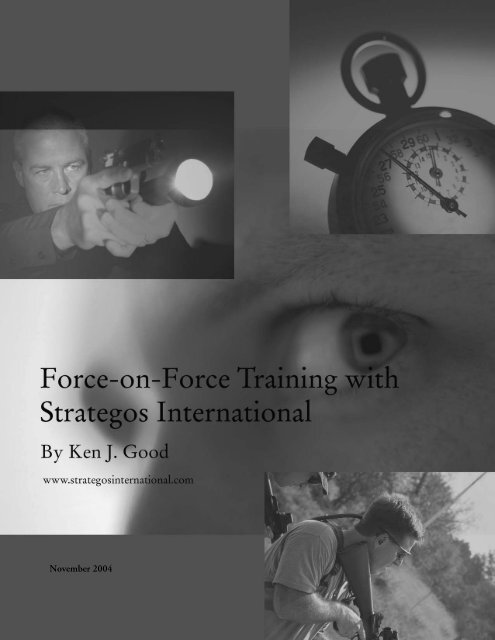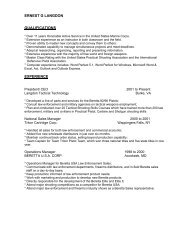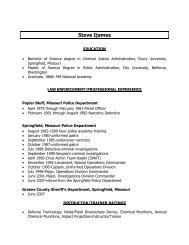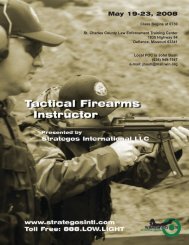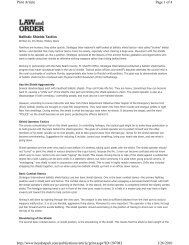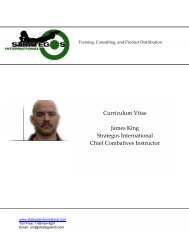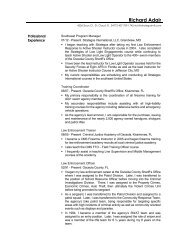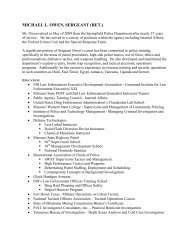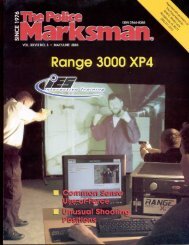November 2004 - Strategos International
November 2004 - Strategos International
November 2004 - Strategos International
Create successful ePaper yourself
Turn your PDF publications into a flip-book with our unique Google optimized e-Paper software.
<strong>November</strong> <strong>2004</strong>
I asked my mother if I could train in some type of martial art. She said yes, but told me to do itsecretly, because she did not know how my father would react to it.My brother and I enrolled in a Kenpo Karate school that was quite a few miles away. We eithertook the bus or rode our bikes (you know the story…school was uphill both ways). For me, it wasnot about the belts, the physical fitness, or the points won in a tournament. It was about dealingwith my deepest fear of confronting my own father who was a collegiate boxer, football player,and former military man and dealing with it head on.To make a long story short, one afternoon my father returned home from an apparently distressfulday at work. My older brother was cooking dinner for the entire family in the kitchen (we rotatedthis chore among six kids). My father started in and we all could feel it coming.Increasing verbal abuse was going to lead to an explosion. I was doing my homework (if you canbelieve that) and my father proceeded to start attempting to pour several quarts of boiling hotliquid on my brother. I told my father not to do that.He slammed down the pot and promptly started to punch me in the back of the head as I wasseated at the table a few feet away.During the fist bashing, something snapped inside me and I was free of any fear. I saw red,literally. I ejected myself out of the chair, rotated violently with a left hand back fist to my father’sface, which opened the entire side of his face up (30+ stitches). The momentum carried mearound where I dropped my other hand below my knees and reversed the rotation to impact theother side of his head. Same result on that side, face split wide open.I hit him so hard that he buckled at the knees but before he could go down, I launched a kick tohis lead leg coming from my now rearward right leg. It cracked his femur, and he went down.I then thought about side kicking him as he was on his knees through a 10-foot high window,directly behind him. I then noticed I had an oak arm rest in my right hand and my dad was tellingme to finish it or he would next time. I do not recall picking it up. I could barely recognize myfather, as there was so much immediate swelling in face which was covered with blood. Iremember time slowing down and me visualizing crushing his head like a soft pumpkin with theweapon now in my hand. It seemed like I contemplated doing it for a couple of minutes. It wouldhave been an effortless stroke. I “woke-up”, dropped the oak piece, and ran outside the door withtears streaming out my eyes.My brother had called the police and they arrived in a couple of minutes. I remember an officerasking me what was going on. I told him I had to defend myself against my Dad and that no sonshould have to do what I just had to do.They went in with me in tow to my father laying on the ground in a dazed state of mind with alarge pool of blood on the linoleum floor, his clothes a deep crimson red.My father immediately contradicted the now assembled family and the police officer told him tostop talking before he arrested him for child abuse. They brought him to the hospital where hespent several days in intensive care to deal with the head trauma. I was 17 years old and hadestablished a new pecking order in the house.I share this dark time in my life to let you know that I have always approached the study ofcombatives for one single-minded focus; that is Combat Efficacy. I am not interested in titles,accolades, associations, or credentials per se.
I later joined the U.S. Navy to become a SEAL and was the honor graduate or met the higheststandard of every single school I ever attended while in the military. I was performance driven tosay the least.I got out the Navy (as we were not fighting anybody – very frustrating) and really thought I wouldnever deal with the combative environment again. Although I had dabbled in other martial arts(and had a few other fights), I really did not see the value of spending my time as a practitionerbecause I generally carried a belt-fed machine gun around to deal with threats while in themilitary environment.I enrolled in college to study computer science and music as a minor (my mother has herMaster’s degree in music). My older brother got all the music genes; I was left with the desire,but no real natural talent for it!I stayed in the Naval Reserve and during that time, as I quite simply needed money to keep thelights on. My reserve Commanding Officer told me about a temporary active-duty over at a FleetTraining Command where the Navy was attempting to teach shipboard security forces to becomemore proficient at defending their own ships while in port against potential terrorist threats.The lead instructors were both former SEAL’s teaching there on a contract basis, one of thembeing Harry Constance, a highly decorated, energetic and really, really funny Viet Nam veteran.He later wrote a book called “Good to Go”. I thought this whole thing was going to be a cake walkthat would have little or no impact on my “vast knowledge” of warfare……There goes that pridething again.One of the programs included something I had never donebefore….Force-on-Force training utilizing Sheridan pump,paint-projectile pistols. They were using red pellets, woolcaps, and eye protection with no other face protection.We later chronographed the guns at speeds in excess of 350-375 FPS….That would account for lots folks immediatelydropping to the ground when struck in the cheeks, lips andthroat.This was at a time when Simunition ® F/X rounds were adistant rumor. We initially saw some .38 rounds and wereintrigued by them. Availability was non-existent. Duringreserve exercises we were using wax bullets launchedfrom S&W .357 magnums.What we quickly noticed that “best practices” for entry workand team tactics were not so good. I was instantaneouslyhooked on this way of training. I can still remember thefirst scenario that I was involved in. It has a hostage situation on the bridge of thedecommissioned ship the training center had custody of. I remember seeing the “hostage taker”holding a gun to the head of “hostage”. I remember immediately closing down to point blankrange and blasting the instructor in the side of the temple and watching him slam to the groundwincing in pain. It was SO REAL to me. Up to that point they apparently have been successfullygetting folks to be indecisive and subsequently chewing them up.At the time we were using about 200 rounds a week for the 36 student classes.
Several years later fate would put me together with another SEAL, David Maynard who hadalready spent countless hours using paintguns with an organized team he personally cultivated.They were a very good 10-man team in the competitive circles of organized paintballtournaments.Dave and I hit it off. Dave started “secretly” adding more rounds to the week’s allotment of the200 “authorized” rounds for scenarios.Over the course of a 2-year period, Dave and I essentially rewrote the entire scope of the courseand the program evolved into a 5-day course that encompassed three, 10-hour days of rigorous,and I do mean rigorous force-on-force encounters. Round count was in the 5,000-7500 range perweek of training. This training was prefaced with another very demanding practical shootingcourse. Annually the school put through 1,800 students, counting both related courses.I still get emails from students that attended those course years ago detailing the level of realismexperienced. There were thousands and thousands of opportunities to serve as an active roleplayer with Opposition Force. We literally covered that training platform in paint from stem tostern, top to bottom. After the festivities we brought in 3 fire hoses to clean the ship up!By sheer repetition, patterns and practices emerged that slowly took shape in terms ofquantifiable behaviors. The next question was to ask was what were the desirable behaviors inthis environment and how does one shorten the learning curve in term of training efficiency for thenext generation.It is also interesting to note that our courses were subject to a laborious process of evaluation inorder to ensure conformity to establish educational standards. As the course curriculum modelmanager for off-site schools we had additional responsibilities. On top of that, the Navyconsidered our courses “High Risk” so there was an additional layer of administrativeresponsibility that was subject to regular scrutiny.Education specialists would pour over the curriculums point-by-point, objective-by-objective andtest-by-test. They wanted and simply required an absolutely objective standard. Think aboutdeveloping a curriculum and standard for maintaining a high-tech missile launcher for all Fleetcommands and you will get the idea.As the director of security forces training on the Pacific Coast, I had extensive conversations withthese members of the higher evolved strata of society. I told them over and over again that theapproach they were advocating was untenable for the actual objectives we wanted to achieve.Finally a bevy of them descended upon our division to show us exactly how to accomplish it.With clipboards in hand to scientifically evaluate each and every action, objective (terminal andenabling) during the defense of a ship under attack by a mock terrorist force they quickly ran intoa hurricane of previous unseen “issues”. Welcome to reality!To quote Will Smith in I- Robot “Somehow I told you so just doesn’t quite get it”.They left the platform with the following recommendations. Continue toprovide written testing platforms to meet training and educationalrequirements. Continue to provide practical exercises; participation in Xnumber of them implies successful completion of the course.In addition to this constant repetition over a 10-year period, Dave and Idecided to strike out on our own and create a company called CombativeConcepts Inc.
We approached local SWAT teams and simply stated that if they would pay for the consumablesand provide criticism we would like the opportunity to test our training concepts out on them. Thisendeavor started gaining momentum and before we knew it, we were training in all differentlocations with a wide variety of folks. Direct feedback from these teams taught us many, manythings including how poor we were at communicating what we were now getting a hold of in termsof practical application.We also regularly ran a drilling clinic on Thursday nights at a large warehouse facility, where for aminimum fee you could participate in the pre-designed drills or scenarios being offered thatevening. Police and military members came from all over the area to test and hone their skills. Itwas a “fightclub” of force-on-force so to speak.I later sold my interest in Combative Concepts to start the SureFire Institute as its foundingdirector. Through this institution we further refined our practical skills, teachingmethodologies/presentations and made countless critical observations and refinements.From there, <strong>Strategos</strong> <strong>International</strong> was formed and we are still climbing the ever-growingmountain.I say all this to let you know that my perspective does not come from a causal viewpoint. Itcomes from over 20 years of persistent, passionate and hands on involvement in this type ofapproach.Now let’s Review the other Side of the CoinOur over-arching goal is to create thinkers, not techniciansthat can recite chapter and verse using the vernacular ofthe tactical arena. I know countless operators that stand onsomebody else’s name for the defense of their positions yethas never really introspectively looked hard and deep atwhat they were actually saying and doing.Simply stated, we do not let people run through a hail oftraining projectiles and allow them to fool themselves intobelieving they are successfully improving their individualskill level.We focus heavily on principles as opposed to technicalminutia.We also steer and mold or training to create an individual orteam that can flow and adapt when presented with newvariables.Almost any good practioner of any high performance human activity will address and understandsthe concept of flow. Flow is that ethereal or difficult to define state of being that those who reallyembrace an activity learn to work within and appreciate.Too much structure as the defining approach in any given study of human activity can inhibit thissought after state. On the other hand, too much freedom without thoroughly understanding thetechnical underpinnings can and often does lead to sloppiness and unintended consequences. Ibelieve there is a balance here. I also believe there is a fairly large left and right lateral limit forlatitude in style approach.
To categorically state that all highly structured events in training are “wrong” is wrong.To hold the view that the introduction of highly unstructured events in training is “wrong” is alsoequally askew.What we found out through enormous number of force-onforceencounters, you can create teams that could beincredibly adaptive, innovative, powerful, and decisive, usingparticular drilling practices quicker than one might believe.Training must be specifically constructed to bring thesedesirable traits out. It can only become manifest if and onlyif that team has the core ethos to embrace sound doctrinethat may be found outside their own mental box. If they arerigid in mind, chances are they are rigid in movement.Note, I did not say excellent scenario construction to createthese teams/individuals, I said drilling practices.Drills are the key in my mind. In fact most of the training weconduct is not scenario based at all. Scenarios are timeconsuming,difficult to properly setup and orchestrate, andinvolve a limited number of encounters, as they shouldreflect the real world where very few shots are ever fired.Don’t get me wrong, scenarios are excellent finishing toolsand must be carefully considered. We are by no meansscenario experts. This is where others shine much morebrightly than us!I had a key trainer in this industry recently ask me something to the effect, “When are you goingto get rid of those paintball guns and switch to the exclusive use of Simunition ® F/X trainingweapons? What you are doing is dangerous and it will get people killed. In fact a DEA officerwas killed right after using a paintgun in training, because he could not properly fire his Sig 226 ina real encounter following the training.”This is one of those series of statements that make me go…HmmmmFirst of all; I refuse to predicate an entire approach on the actions of few weak-minded, lesserskilled individuals that do get killed in gunfights. We will always have them among use, whywould I ever use that as the training standard?I further responded with, I have been to the authorized Simunition ® Safety Supervisor TrainingCourse and I am fully aware of the espoused doctrine. Have you been through one of mytraining courses? “Uh….no…..” Okay then, your conclusions or assumptions may be in error, asyou have no real first-hand reference points to base your opinions relating to how and why weconduct force-on-force training.The fact of the matter is, I can point to a slew of Simunition® training related deaths. Do I think itwas the conversion kit or the ammunition? Do I think it was the content contained in thesupervisors course that created these mishaps? Do I think we should stop “Reality-based-Training” because of these clear lethal risks? Absolutely not. They can and should be 100%mitigated and hence the Safety Supervisors Course and Ken Murray’s new book.
Rolling Back what We doThis idea that forcing officers to acknowledge hits weakens their will or programming them forfailure in actual combat is not something I subscribe to. Here is a few excerpts from participantsthat were forced to undergo the so-called negative effects of acknowledging they are hit duringtraining:FYI, one of your former students (of the one-day low light training) was involved in a very nasty shooting lastnight (8/13/00). He did an excellent job. Basically, they were clearing a studio apartment that wassupposedly the victim of a burglary 'in progress'. As officers were clearing the 'vacant' apartment, two armedgunman suddenly rushed through the front door with guns pointed at the officers. Your former studentquickly engaged in a gunfight causing the gunman to retreat to the front door area (the other gunman fled).With no way out and the fear of the gunman waiting outside, the officers decided to handle their exit on theirterms….. To the officer's surprise, the gunman was outside with his gun drawn waiting for the officers to runafter him. Another exchange of gunfire resulted in the gunman taking one to the arm and another to the righteye. No injuries to the officers. I spoke with the officer and he credited your training for his success in thisscenario. So....... in the interest of applying your training to more than just a select few, I am asking if you'dbe interested in conducting your training here? Please let me know what your fees would be.My name is Steve Mescan and I took you Team Tactics Course in May of 1999. I am a SWAT Team memberfrom the city of Pittsburgh Bureau of Police. I would like to take minute to express one of my experiences.On August 27, 1999 I was returning to the station in a quiet area of the city, at approximately three in themorning. The front of Zone 6 station is almost all glass and not bullet proof. While walking into the station,two gunman in a vehicle, one with a 9 mm, and the other with a .45 cal, opened fire on me and three otherofficers. The first round missed my head by inches and then I was struck in the foot once by a 9mm and thenwith shrapnel from a .45 caliber.As the gunfire erupted I found myself, even though I had been shot, on my shooting platform, working theangle, and rather than running from the threat putting them under duress. Though I did not fire a shot,because my backdrop was full of residential houses, the suspects who were caught stated they saw me pointmy gun out towards them, which caused them to flee. In all 29 shots were fired at the station.I credit the training I received from you and your cadre as to the reason this incident didn't turn out worse.First I realized the back lighting situation and immediately told another officer to turn the lights off. I began tomove at the suspects to acquire a site picture while doing so I caught myself "breathing up" and controllingmy adrenaline. I knew I was shot, but because of the type of training and duress that I was put under duringthose three days at Team Tactics, made 29 rounds feel like a walk in the park. I believe that the training Ireceived helped me not react so quickly, that I simply reacted with emotion and began to "spray and pray" outthe front of the station house.Instead, I was able to remain disciplined and turn the tides of the encounter. I would like to thank you andyour staff for the training I received. It may have saved my life and the lives of others. I can say, as a trainer,that the Team Tactics Course was the best course I have been to in my seven-year career.Keep up the good work and if there is anything I can do for you guys please don't hesitate to ask! I Hope totrain with you again in the future!!Steve MescanPittsburgh SWATKen Good and his cadre continuously demonstrated how truly effective and properly conducted Force onForce training will have students "running their own mental videos" over and over in their heads - long afterthe training is over - searching for the points things "went south", the *point at which* the one critical mistake Imade occurred, how to avoid that / what I need to do differently "next time", what I did right, what my partnersdid right, etc., etc.
I could go on and on with guys that we initially trained all the way to the present that are currentlyin the sandbox that take the time to email me their thoughts and perspectives. But I believe thepoint is made. Those that go in harms way speak the loudest. Those that have been in gunfightsprior to training and after the training we advocate have stated the approach in a powerful, deepseatedone that will manifest itself when called upon.Why are the letters and emails notstreaming in telling me that the training istaking them in the wrong direction?I believe more than anything else, folks donot successfully engage known threat’s atrelatively close ranges simply becausethey have not had the repetitionsnecessary to properly execute the host ofoptions available to them in theseencounters. They have no valid referencepoints.Without these repetitions the initial response to being fired upon is to quickly establish theposition I refer to as “vertical fetal”. Cover is immediately sought and the head and eyes arelowered as if protecting oneself from a falling object. The weapon is brought out of the pictureperfect position for return fire and directed to parts unknown.We originally constructed a drill to specially deal with the innate phenomenon. It was called the“gauntlet” drill. The shooter was forced to walk out in the middle of a maze of potential firingpoints and directed to walk forward. Hesitant, tentative stepping was not allowed. You had tomaintain what we refer to as a “shooting platform”. Threats of various levels and distance whereinitially presented to the shooter and he had to quickly determine shoot or no shoot. If fired upon(the threat could fire one round) and struck, the shooter was permitted to fire back one round. Ifthe shooter hit the threat before he got a shot off, the threat was to stand down.It was a three-dimensional shooting gallery with pain penalties for not paying attention and areward for finding and eliminating the pain potential with accurate, fire. No spray and praypermitted. One-round was all you had to get the job done.Initially the threats would be presented in front of the shooter, but over subsequent runs, thethreats would develop from the side, then the back, then multiples would start appearing. Thenwe would start the same process over with a partner and then done again with 2 pairs at a time.We videotaped this and put the replays in a slow motion so that participants could see first hand,frame by frame; from the outside perspective what they were actually doing during the initialobservation and orientation phase of the drill. It was quite revealing. But once consciouslyunderstood and acknowledged, the participants over a several day period would eliminate a largepercentage of non-productive flinching, ducking, and overreactions. They would begin to functionmore like shooting machines. If threat, then shoot. No hesitation. Additionally the number of noshoottargets being engaged would significantly drop.
Drills, Drills, and more DrillsDrills allow one to see over and over again what it looks like to have somebody point a gun atthem and engage them.Drills allow you to see what looks like to gun somebody down from a variety of positions, lightingconditions, and given the constraints of their chosen profession.Drills allow you to develop valid orientation to the incoming stimulus and therefore eliminate manyacts of desperation, fear, and purely primitive reflex. Again, this results in a lower number ofimproper engagements of no-shoot threats and a lowers the percentage of misses that commonlyoccurs in these types of fights.I think at the core, you have to create an individual that can remain relatively calm under duressso a multitude of tasking can successfully be accomplished.This means repetition, repetition, and more repetition. Not just any repetition, but repetition of theright kind, doing the right things. This is not a new or novel concept. This has been known forgenerations.Back to the individual who told me what we do (having never seen it) is “dangerous”.I responded with, when I went through the Safety Supervisors Course, I shot 3, count them, 3rounds in all the given scenarios I was involved with over a 3-day period of instruction on how todeploy this realistic gunfight technology. Although the course is definitely not designed to be atactics or shooting skills oriented course, instinctively there is something wrong with this picture(at least in my mind).I then asked this individual if he was willing to sponsor my company with Simunition ® Markingcartridges on the magnitude of 5000+ rounds (the number of paint projectiles we go through acourse in a week) for 20-25+ weeks a year. Do the financial math.What I have concluded is that if you can get individuals and pairs to learn to properly flow throughwell-conceived drilling methodologies, these same people that will comprise a team, bring thatpowerful flow capability to the larger element while participating in scenarios.Pairs that have learned to immediately micro flank whenrequired, horizontally and vertically displace, tread theground properly, bi-laterally shoot, communicate, maintainbreath control and situational awareness, remain calm whenfired upon, maintain posture, manage ammunition, findcross-angles, understand pace issues, and have developedand unwavering, unflinching desire to pressure the opponentat every opportunity, generally make really good substratefor a team.These attributes and skills are best cultivated at drilling level,not the scenario level.Let’s take a drill that we do and use it as a practical example.We have a drill we call the 2 vs. 2 drill (one of many).The goal of the drill is fairly simple. Your pair is to prevailover the opposing pair. This is not a judgment drill much like firing your weapon live fire on therange. One goal, hit/eliminate the targets presented in front of you.
Two pairs start at the opposite ends of the field that is populated with obstacles (cover andconcealment consisting of vehicles, 55-gallon drums, and whatever else you can drag out there).The field is generally over 100 yards in length, 50+ yards wide.You can choose to move at any distance, speed, angle that you desire within the given trainingarea. You can shoot whenever you want, at whomever you want, at whatever speed, method ornumber of rounds you desire.The drill is done with pistols, rifles, day and night.The drill in fact teaches you a multitude of things that are required to accomplish your goal ofhitting the moving, thinking, and return firing targets in your area:- Posture- Breathing- Movement- Relative Relaxation- Horizontal & Vertical Displacement- Proper Use of Angles- Ammo Management- Communication- Pace- Flanking- Closing- The Value of Bi-lateral Shooting- Sighted or Unsighted Fire- A Myriad of Lighting Issues- And Much More….While participating in this drill, you are required to acknowledge when somebody on the opposingforce impacts you with a projectile by taking a knee in place, your drill is over in terms ofengagement.Tell me how the drill is going to work if all participants in the drill simply choose to ignore the factthey are getting hit. Do we just stop doing it because the risk out weigh the known learningbenefits cited above?Tell me what the benefit is when an individual successfully maneuvers himself behind anopponent and unleashes an accurate volley of rounds up and down the spine and back of thehead of an opponent only to see that opponent turn around through the hail of bullets and beginto return fire until both individuals are hurling empty weapons at each other?As I live on the East Coast now, I have had the privilege of meeting and interacting with some ofboys from NYPD Emergencies Services Unit (ESU). Last year, I was invited to a large trainingexercise where the head trainer for ESU (awesome person, experienced operator, severalshootings) and I were discussing this exact issue. He also held the opinion that no members ofthe “good guys” should ever go down. Fair enough.As this particular exercise unfolded, the team leader rolled out of his vehicle to address adisturbance directly in front of him. As he did so, another individual clearly appeared out of asecond story window. He had a Simunition ® F/X converted AR15, very accurate.
The team leader subsequently received at least 10 rounds to the head and simply moved back acouple of feet. He took another 5 rounds to the head. He then ducked down behind the vehicleand started barking orders, only to return to the exact same spot he just got shot from to giveadditional direction. He took another 5 rounds to the head. He then causally walked closer to thebuilding and eventually made entry. The construct of the scenario and the rules of engagementallowed for this type of behavior and he was taking advantage of it either consciously or subconsciously.I am using this example to illustrate the extreme of the rationale. At some point there needs to bean acknowledgement that this is not an acceptable way to teach somebody to win gunfights. Itneeds to be much more than, “Great job in the scenario, and oh by the way, you had 15simulated .223 rounds pass through your brain bucket….But let’s move on”.In my mind this is far more deadly than asking that officer to take himself out of the scenario for afew moments/minutes to recalibrate his actions/movement before moving on. I pointed this outto my good friend and he also agreed there was something inherently wrong with the decree that“you never do down” in this type of training.Where this line is drawn is somewhat subjective in my mind.We take a slightly different approach. In drills we force you to acknowledge your hits not matterhow “trivial”. We are not encouraging participants to quit, fall down and say “I’m dead”, or evenmake an evaluation as to whether or not that hit or hits was survivable. This is an importantdistinction. For years, we used the phrase, “call your hits”.We tell folks, in an actual confrontation, fight till you are unconscious, and if you are unconscious,do not worry about it anymore.I challenge anybody to poll the thousands of students I have interacted with over a 20-year periodwith a specific question. Does the training methodology presented instill a strong sense and driveto prevail, overcome, adapt, and dominate threats on a variety of levels while at the same timechallenging you to become calmer and calmer while doing so or does it teach you to capitulateunder pressure?In scenarios we can and often do create generally unstoppable officers. However, if I am acontroller, I will put the officer down for a few seconds if I see multiple hits as a result of sloppybehavior. I force him to acknowledge what just happened and then send him on his way toconquer the heathen horde.In terms of training weapons, we take a hybrid approach. We do our high volume (read high costof projectiles) with high-quality paint weapons, and then we do full mission profiles (low volume offire – generally speaking) with converted firearms using Simunition ® Marking cartridges so thatyou do have the opportunity to use the kit you are going to bring to the party.What exactly is accomplished by forcing a participant in this type of training to take a knee whenstruck and evaluate what just happened? Although most certainly all bullet impacts are not fatal,just keep in mind we are not talking about jabs to the face either!Let me also state that for 20 years I have forced my self to acknowledge my hits. It is the hardestthing to do at times. It is not easy for me, the instructor to admit/show the “students” they justshot the crap out of me. But ultimately it wins their respect if I do so.
I still get pissed and only want to fight more when struck. I do not consider myself killed, dead orotherwise…Stupid maybe…but not dead. This is virtually a universal behavior by most seriousoperators. Pain does not destroy them; it wakes them up. It motivates them to keep going andimprove. They do not want to stop, period.• By taking a knee, you are allowing yourself the opportunity to honestly evaluate not onlywhat just happened moments ago, but it allows you to question your basic assumptionsthat were brought with you prior to this particular encounter as well as reevaluate yourentire framework if that is what it takes.• This time allows you to evaluate why your predictions of the future events wereinaccurate.• This time allows you to see (read replay) right then and there why choosing to hold thatspot of ground was not a good choice.• It allows you to replay the movement of a superior practioner downrange that just gunnedyou down.• It allows you to consider that fact that you may or may not have over or under extended.• You have to think about what you did or did not say to your partner(s) prior to impact.• You have to eat humble pie for a few moments and drop the shield of pride in order tolearn how to avoid that series of pattern of events again.The greatest value in force-on-force training is not weapons manipulation (Action Phase of theOODA Loop) but the immersion into and challenging of the processes associated with the farweightier phases of the loop: Observation, Orientation and Decision.“Your Kung Fu is Weak!!!”Let’s not get too pushy here.From my limited perspective, there needs to be an allowance for a wide variety of applications ofthe RBT tools. If a trainer needs to develop “in the can scenarios” that require quantifiable andspecific skills sets to be addressed and liability to be covered with specific documentation, thenscript the heck out of it and do not allow any deviation.One the other hand, if I have a team of folks that need to go in a highly dynamic and constantlychanging situation, I am not going to set them up for failure by not allowing them to deal with agenuine element of chaos on the front end. I want these guys to experience the benefits ofadaptive learning. Improvising will be rewarded; static, linear, easily read movements will bepenalized.Full-mission profiles might include highly skilled role players that are free to adjust as necessaryto engage the incoming forces. Let the chips fall where they may.I think this idea is considered to be dangerous by Ken Murray.“Improvisation can also lead to dangerous confrontations between student and a roleplayer because in the absence of specific guidelines, the training staff will have a hardtime anticipating what exactly the role player or student is likely to do next”- Page 127
There is an extremely valid point here. I balance this point with; there is a fundamental differencein feel between choreographed kata and free-sparring within limits. Both can have a place.I cannot tell you how many guys think they can really fight because they operated almostexclusively within a known set of parameters. Take the gloves off and you see what is under thehood. Last time I checked, fighting did not look like the controlled environment of the dojo and infact I had no idea what my opponent is likely to do next. That is reality.I went to a SWAT conference on the East coast last year where I had the opportunity to share aplane ride and some dinner with Tony Blauer. Tony and I do not agree on all the specificmethodologies or style of training for combatives but I will say that Tony has a powerful gift ofcapturing concepts with some really great phrases that just make good sense.During dinner we were dissecting some ideas and Tony said, “All training is fake. It is our job astrainers to make the fake stuff as real as possible”. Well stated.Balls to the wall fighting when participants are unskilled, unfamiliar and unprepared is not aproductive way to spend your training time either.The key here for me is having good role players and a situationally aware controller that canimprovise within limits. They need to understand when the person or persons they are facing arehaving a difficult time or are simply breezing through the situation. We used and still use a colorcode initiated by the overall controller of the situation. Going “Green” means, aggress them witheverything you have. “Yellow” means back off because the current level of resistance is too high,but continue to offer friction with a view to keep it challenging but solvable. “Red” meansabsolutely back off as the person or team is simply overwhelmed and needs to be offered little orno resistance at this time until they obtain sufficient levels of skill to deal with it.When you boil it all down, we are ultimately talking about fighting here, not a program or a set ofvolumes that can be manipulated on a computer screen.This type of interaction cannot be metered by using a checklist. It is dynamically facilitated onlyby an experienced crew of trainers that have the best interests of the participants in mind.Prevailing over the student is not the goal. Teaching and pushing them to their personal limits is.Strong and weak individuals and team must be accounted for.We have a saying in our combatives courses. As a good training partner, do not overly resist, butdo not overly assist. On one hand you are frustrating your partner, on the other hand you areinstilling a dangerous false sense of security. Train to improve your partner not prove that youare better than him. It is on the fly metering not specifically measured by a known set ofparameters.Back to the game of Water Polo. When I was a senior in high school, I transferred to a publicschool to play with my friends in an effort to capture the California state championship. We had 4returning All-Americans and we were supposed to be the dominant force that year.The coach of my new school John Schmidt (a member of the U.S. Olympic team) suddenly took aturn for the worse and died quite suddenly of a brain tumor.The Volleyball coach who had no experience with this particular game replaced John. Then newcoach was a particularly hot-tempered individual and was characterized by his overwhelming lackof regard for the actual talent and experience he had on the team.
Fundamentally, the offensive strategy of water polo is not energized by set plays. It is a series ofprobes, picks, drives, switches in an effort to create and take advantage of emergingopportunities that can be exploited. This new coach was going to bring his new paradigm into thegame. He was forcing us to use set plays of his own design or better said, he was introducing ahighly scripted approach to solve problems that will always develop dynamically. The amazingthing is there was nothing broke about this team! It was already a well-oiled machine.To make a long story short he quickly managed to destroy the morale, the synergy and ultimatelythe entire core infrastructure of the team and it went down in a ball of flames.A statement to me by this coach characterized my last game in high school. We were battling tostay in the regional tournament. I was the tournament’s leading scorer at the time. My coach toldme to stop scoring or he would take me out of the game. I asked him what the fundamental goalsof Water Polo were. He could not answer the question! I told him it was to score as much aspossible and prevent the opponent from doing the same. Then I asked him; which of those goalswas I not supporting. No answer with words.The last game the coach benched me for 3 quarters. We were losing. I was put in the water; fastbroke down the pool and scored. He was good on his promise; I was immediately yanked backout of the water and sat down. We lost the game as the entire team was tied in knots not justbecause of me, but because his entire framework and approach stifled flow and the inner gamerequired to win at that level.Fighting like Water Polo is not a scripted event. This especially holds true in the no holds barredworld of gunfighting.Be careful not to exclusively train like it is.I will leave you with this, No one can fully teach you howto be a great painter or musician by chapter and verse.A good mentor will cultivate that which is within. It isuniquely inner human gift energized by creativepersonality and desire to bring the inward, outward forothers to experience.In many ways fighting is the same way, but the stakesare much higher.Respectfully,Ken J. Goodwww.strategosinternational.comemail: ken@strategosintl.com


